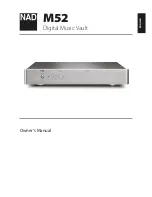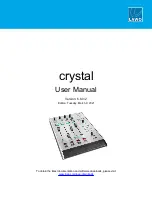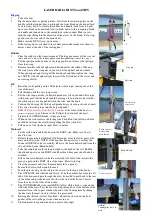
4
en
9. Remove the syringe from the valve housing after cuff inflation.
Leaving the syringe attached will keep the valve open, permitting
the cuff to deflate.
10. Check to verify that the cuff inflation system is not leaking. Integrity
of the system should be verified periodically during the intubation
period. Any deviation from the selected seal pressure should be
investigated and corrected immediately.
11. The device should be secured in the patient’s airway following
currently accepted medical techniques.
12. Follow hospital procedures regarding the suctioning of the airway
lumen to remove secretions.
13. Prior to extubation, deflate the cuff by inserting a Luer tip syringe
into the cuff inflation valve housing and removing the gas mixture
until a definite vacuum is noted in the syringe and the pilot balloon
is collapsed.
14. Extubate the patient following currently accepted medical techniques.
15. Discard the endotracheal tube using current accepted medical
standards for disposal of biomedical waste.
WARNINGS
• Each tube’s cuff, pilot balloon and valve should be tested by
inflation prior to use. If dysfunction is detected in any part of
the inflation system, the tube should not be used and should be
returned.
• Do not overinflate the cuff. Ordinarily, the cuff pressure should
not exceed 25 cmH
2
O. Overinflation can result in tracheal damage,
rupture of the cuff with subsequent deflation, or in cuff distortion
which may lead to airway blockage.
• Deflate the cuff prior to repositioning the tube. Movement of the
tube with the cuff inflated could result in patient injury, requiring
possible medical intervention or damage to the cuff.
• Various bony anatomical structures (e.g., teeth, turbinates) within
the airway or any intubation tools with sharp surfaces might
jeopardize cuff integrity. Damage to the thin-walled cuff during
insertion will subject the patient to the risk of extubation and
re-intubation. If the cuff is damaged, the tube should not be used.
• It is essential to verify that the tube position remains correct
after intubation, especially when a patient’s position or the tube
placement is altered. Any tube mal-position should be corrected
immediately.
• If extreme flexion of the head (chin-to-chest), movement of the
patient (e.g., to a lateral or prone position), or tube compression
is anticipated after intubation, use of a reinforced tracheal tube
should be considered.
• Syringes, three-way stopcocks or other devices should not be
left inserted in the inflation valve for an extended period of time.
The resulting stress could crack the valve housing and allow the
cuff to deflate.
• Excessive amounts of lubricant can dry on the inner surface of the
tracheal tube resulting in either a lubricant plug or a clear film that
partially or totally blocks the airway.
• During an MRI scan the pilot balloon should be secured near the
Y connector of the ventilator circuit at least 3 cm from the area of
interest to prevent movement and image distortion.
Cautions
• The use of Lidocaine Topical Aerosol has been associated with the
formation of pinholes in PVC cuffs. Lidocaine hydrochloride solution
has been reported not to have this effect.
• Diffusion of nitrous oxide, oxygen or air can either increase or decrease
cuff volume and pressure. Inflating the cuff with the gas mixture which
will contact its external surface is recommended as a means to reduce
the extent of such diffusion.
• Inflation of the cuff by “feel” alone or by using a measured amount
of air is not recommended since compliance is an unreliable guide
during inflation. Intracuff pressure should be closely monitored with
a pressure measuring device. The pilot balloon is only intended to
indicate the presence of pressure or vacuum in the cuff and is not
intended to provide an indication of pressure level.
• Avoid exposure to elevated temperatures and ultraviolet light
during storage.
• The 15mm connector is seated so that it can be removed with effort
if pre-cutting of the tube is desired. Follow the DIRECTIONS FOR
USE to evaluate the tube and connector for suitability if pre-cutting
is considered. Always assure the connector is firmly seated in both
the tracheal tube and the breathing circuit to prevent disconnection
during use.
• Non-standard dimensioning of some connectors on ventilatory or
anesthesia equipment may make secure mating with the tracheal tube
15mm connector difficult. Use only with equipment having standard
15mm connectors.
• If the device is lubricated prior to insertion, follow manufacturer’s
application instructions.
• Use of lubricating jelly to ease connector reinsertion is not
recommended as it may contribute to accidental disconnections.
• The stylet length is specifically set for compatibility with this particular
tracheal tube. Do not cut the stylet to any other length.
Summary of Contents for Shiley 18710S
Page 2: ...2...
Page 36: ...36 Shiley DEHP DEHP DEHP Shiley 15 ORAL 1 2 3 4 15 5 6 ru...
Page 37: ...37 ru 15 7 8 Minimal Occluding Volume Minimum Leak 9 10 11 12 13 14 15 250 Y 3...
Page 38: ...38 ru 15 15 15 15 73 www covidien com Covidien Covidien Covidien...
Page 57: ...57 el 7 8 9 10 11 12 13 Luer 14 15 25 cmH2O MRI Y 3 cm PVC...
Page 58: ...58 el 15 mm 15 mm 15 mm 15 mm 73 www covidien com Covidien Covidien Covidien...
Page 64: ...64 Shiley DEHP DEHP DEHP Shiley 15 mm ORAL HCl 1 2 3 4 15 mm 5 6 bg...
Page 65: ...65 bg 15 mm 7 8 9 10 11 12 13 14 15 25 cmH2O Y 3 cm PVC...
Page 66: ...66 bg 15 15 15 15 73 www covidien com Covidien Covidien Covidien...
Page 71: ...71 ko 9 10 11 12 13 Luer 14 15 25cmH2O 3 way MRI 3cm Y Lidocaine PVC 15mm 15mm 15mm 15mm 73...
Page 72: ...72 ko www covidien com Covidien Covidien Covidien...
Page 75: ...Page Left Intentionally Blank...





































